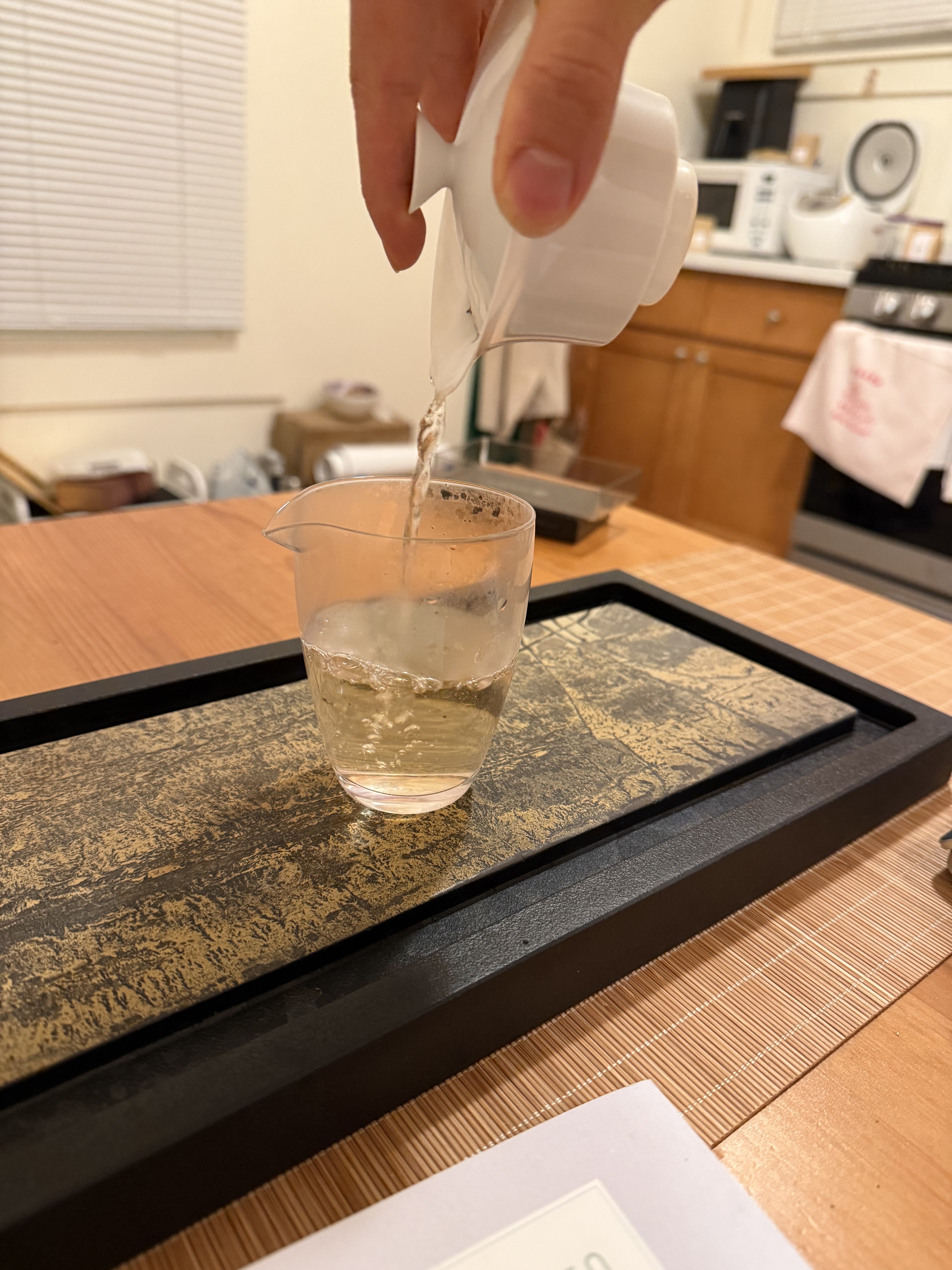This is a substack worthy subject. Yet I'm not posting this there, because this whole experiment sucked and the conclusion was that I should just drink more tea as the oldheads say.
My goal for this experiment was to optimize the water I use to brew my tea. I have optimized it in the past, but now I'm trying to recalibrate myself with the tea community hyping up Saratoga as the current best water choice.
Why do you care about water?
80% of tea is water. It seems obvious but most people don't really think about it much at all. It will seem more obvious if I direct you to the fact that coffee people REALLY care about water. Arby of EmpiricalWater, whose water recipes I use daily and used for this exact blog, makes his water for coffee first, tea second (explains why there exists points of contentions over his water recipe).
Is this just another way for pretentious teaheads to min-max the tea experience™? Yeah. It really does matter though. The water you use can really influence your tea preferences. I prefer to think of it as optimizing my setup to fully enjoy the full spectrum of tea.
Definitions
First blog post, so here are some basic definitions of things I will mention:
| Term | Definition |
|---|---|
| TDS: | Stands for Total Dissolved Solids. A number that measures all compounds in a body of water, think of minerals, organisms, salts. Does not measure the actual chemical compounds, two water with the same TDS can taste very different. |
| Reverse Osmosis / RO | A very, very good water purification process. Brings the water down to ~15 TDS, combined with deionization (DI) it brings the water down to 0 TDS, pure H2O. Not that good for tea brewing actually (barring specifics), usually people remineralize 0 TDS water in their desired way and use that (crossover with acquarium hobbists). Yes I have a full RO/DI system at my place. Please don't ask how much it costs. |
| EmpiricalWater Glacial | A mineral concentrate, recipe by Arby of EmpiricalWater. Designed to be mixed back into filtered water and used to brew coffee/tea. My main water for pu'er until recently, when EmpiricalWater was called out by some knowledgable tea drinkers so now I'm experimenting again. |
| Saratoga | Funny blue glass water company used by the funny morning routine guy. Apparently really good for tea. I'm hoping that's not the case cuz this shit is expensiveeeeeeeeee |
| 101 7542 | Just a name for a famous factory sheng pu'er tea. Factory means it was produced by one of the famous factories. Pu'er is a type of aged tea from Yunnan. 101 means this is the first batch produced in 2011. 7542 is the tea recipe number, 75 = recipe developed in 1975, 4 = uses 4th grade leaves, 2 = produced by factory number 2 (Dayi). Pains me to TLDR this much but this is the basic idea. |
| Young Sheng Pu'er | Sheng means raw (TLDR, unbatch-fermented, as opposed to shou (ripe) pu'er. Young sheng pu'er is pu'er tea that hasn't aged that much (0-5 years). Acts like a completely different tea compared to medium-aged and aged pu'er. |
| International Tasting Mug | Small mugs used as the international tea tasting standard when evaluating a tea. Most tea taste like shit evaluated this way and it's horribly biased but it's a standard. Usually though teas are evaluated at 2g/100ml brewed for 5 minutes, with 100℃ water. I opted for half the ratio. |
P.S. fun fact, tea (especially pu'er) can range from thirsty to hydrated. This is why most Western pu'er storage solutions are not designed for aging (which takes temperature and humidity into consideration), but are designed for drinking (which only considers humidity). Rehydrating the leaves through Boveda packs (another crossover with cigar hobbists) can make it so that the leaves soak up a lot less water during brewing, so the actual water used matter less.
Actual Comparison
I sat down with three tasting mugs and started brewing each. One using half tap water and half reverse osmosis water (pure RO water does not work well on most teas, but a combination of tap / filtered water seemed to work great for some). One using the EmpriicalWater Glacial recipe that I always stick with. The last with glass bottled Saratoga still water.
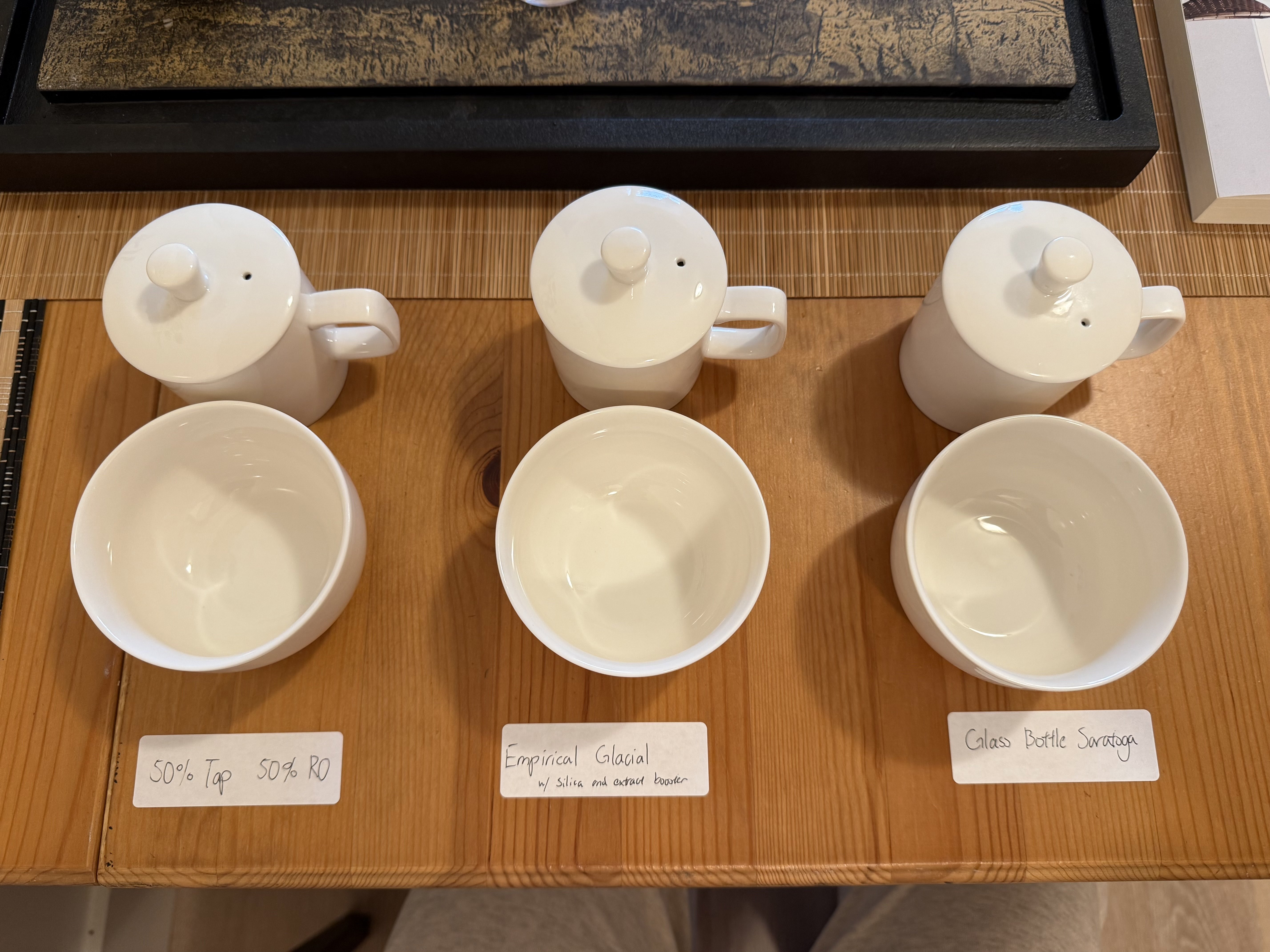
7542
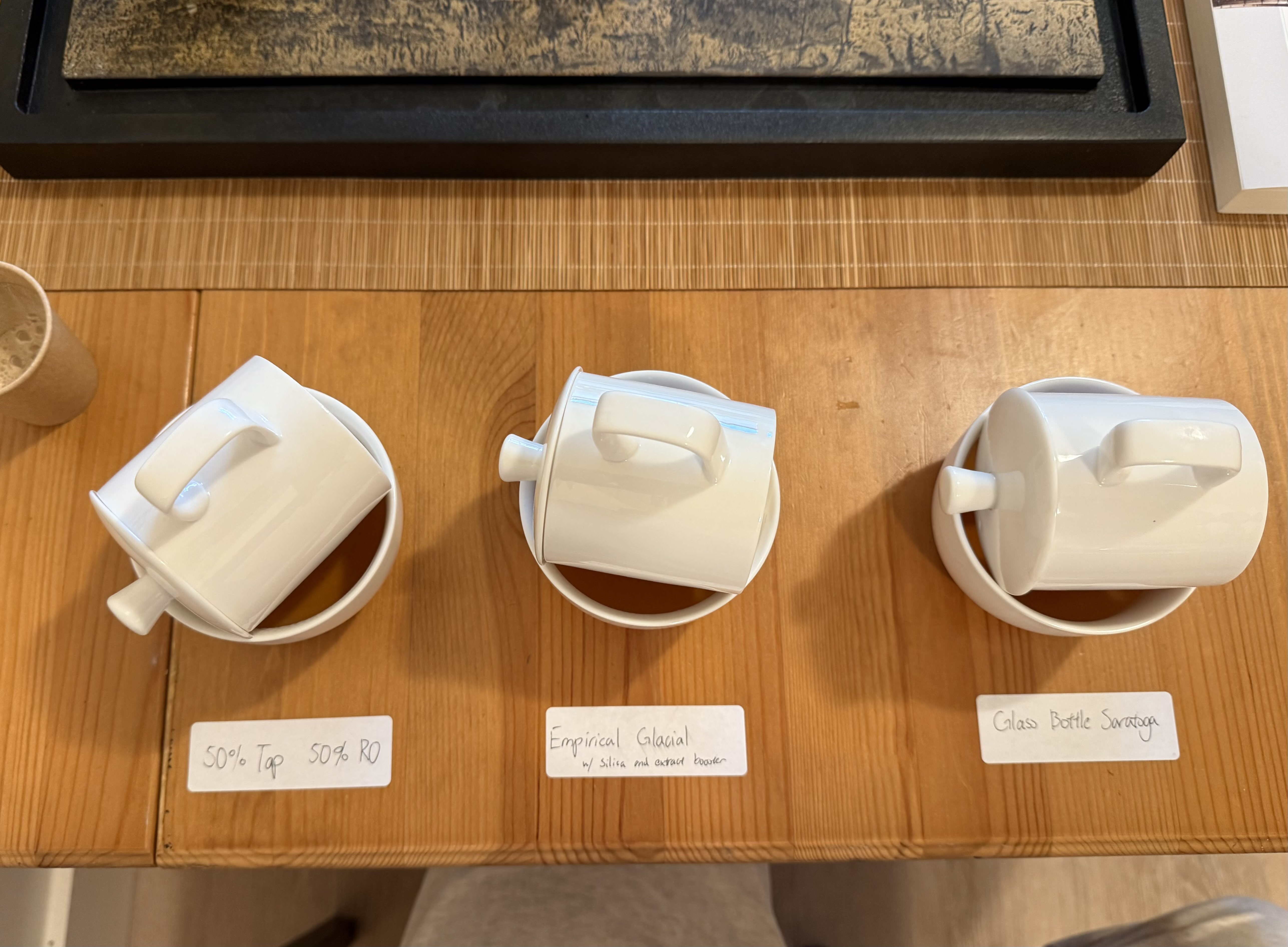
These are the notes I took for the session as I was drinking.
Water comp w/ 101 7542 1.5g/150ml
Tap/RO: slight bitterness, sweetness, not a lot of punch Glacial: def thicker, more mouth drying and astrigency Saratoga: thinner and smoother,
extraction: glacial > saratoga > tap and ro
fragrance: tap and ro >= saratoga > glacial
color vibrancy: saratoga > glacial > tap, which is noticeably dul
preferance: idk, saratoga > tap > glacial ig?
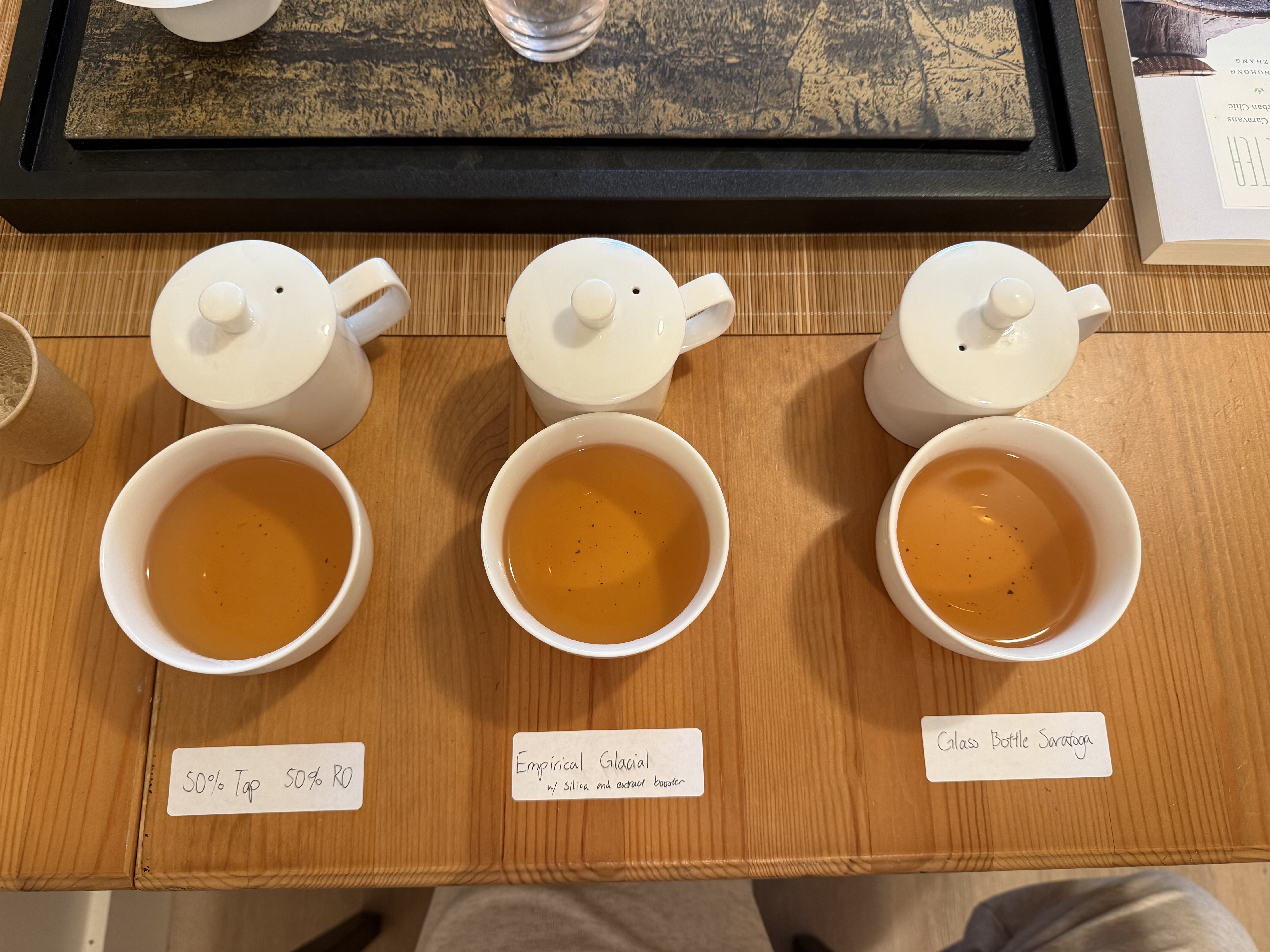
My actual thoughts are all three cups of tea tasted like shit. My acid reflux was about to kick in (average post-2006 7542 session). Also I'll admit, I did not taste a huge difference at all. These are like tiny differences that could somewhat be attributed to placebo. Conclusion is meaningless despite my kinda cool organized tasting notes.
I decided to continue with my experiment.
2025 Farmerleaf Liu Dui
Liu Dui is just a name (I think). This is a classic cheap young sheng. From William of Farmerleaf.
This one I did not even bother to write notes of. Everything just melted into each other. Definitely better tasting than the 2011 7542 (fuck 7542, all my homies hate 7542), nice and floral, some greener oolong notes ('pulong' is no joke).
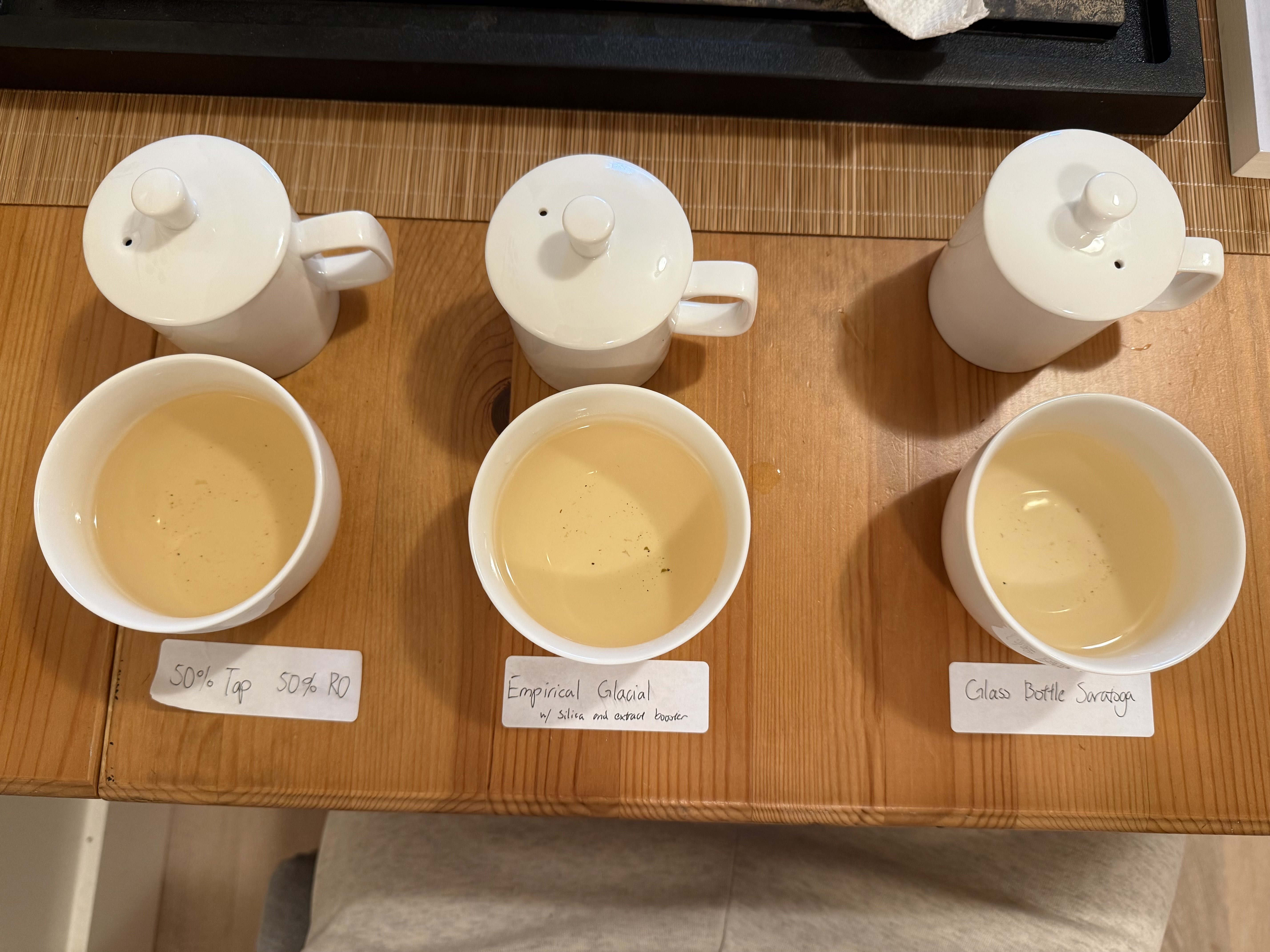
At this point, I still had some more teas lined up. My goal was to run through an aged factory sheng (7542), a young sheng (Liu Dui), a shou/liubao, a Taiwanese oolong, maybe some more aged oolongs... but by this point, I'm like, is this really going to work? Will this even yield any conclusions? Will I enjoy drinking these teas and doing these comparisons at all?
Thus as a dopamine-maxxer aka hedonist, I decided to only do what I enjoy and just give up on this little experiment, and instead actually attend my CS188 lecture.
Conclusion?
Later that night, I had a chill session with the 1980s Liubao from QuicheTeas/TSH.
I used tap and RO, as it was basically free if you consider the cost of my RO machine and deionization stage moot. While drinking, I was like,
"This isn't that great compared to usual. I'm not getting any of the nice, lower creamy sweet notes."
Then it hit me. This was more poignant commentary I've had on the impact of water on tea than anything I have written in my side-by-side comparison.
Really, throwing myself into a whole new brewing style with the whole tasting mug thing was not a good idea. I need as many control variables as possible, and since brewing how I usually do (gongfu) side-by-side isn't really possible with water as a variable (I only have one kettle!) I opted to focus on the side-by-side aspect instead of the familiarity aspect.
Looking back though, a tea really only shines best when it's brewed by you in the way you usually brew it. And who gives a shit how a tea performs in any other way? TLDR, side-by-side comparisons are scams, and knowing a tea, keeping it in my memory, makes a comparison like this so much more meaningful.
I think I'll listen to the oldheads this time, and just drink more tea.
